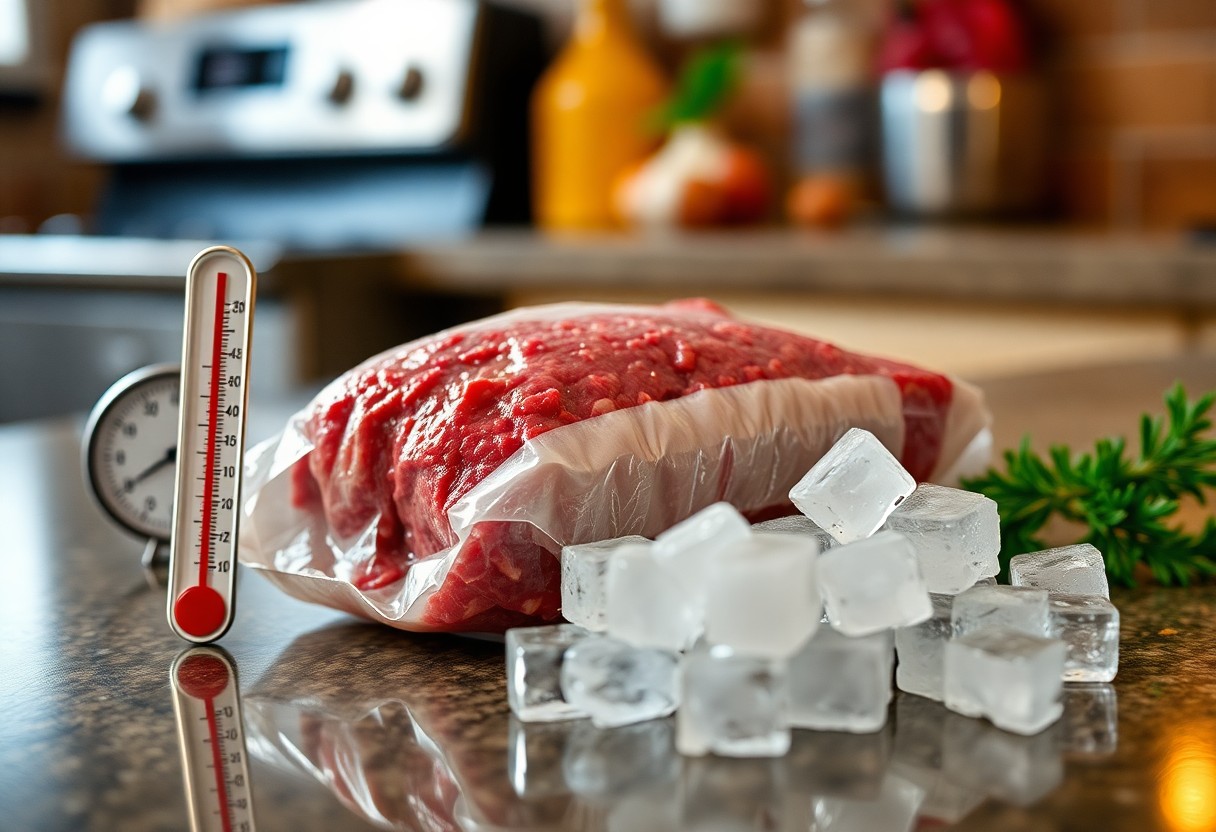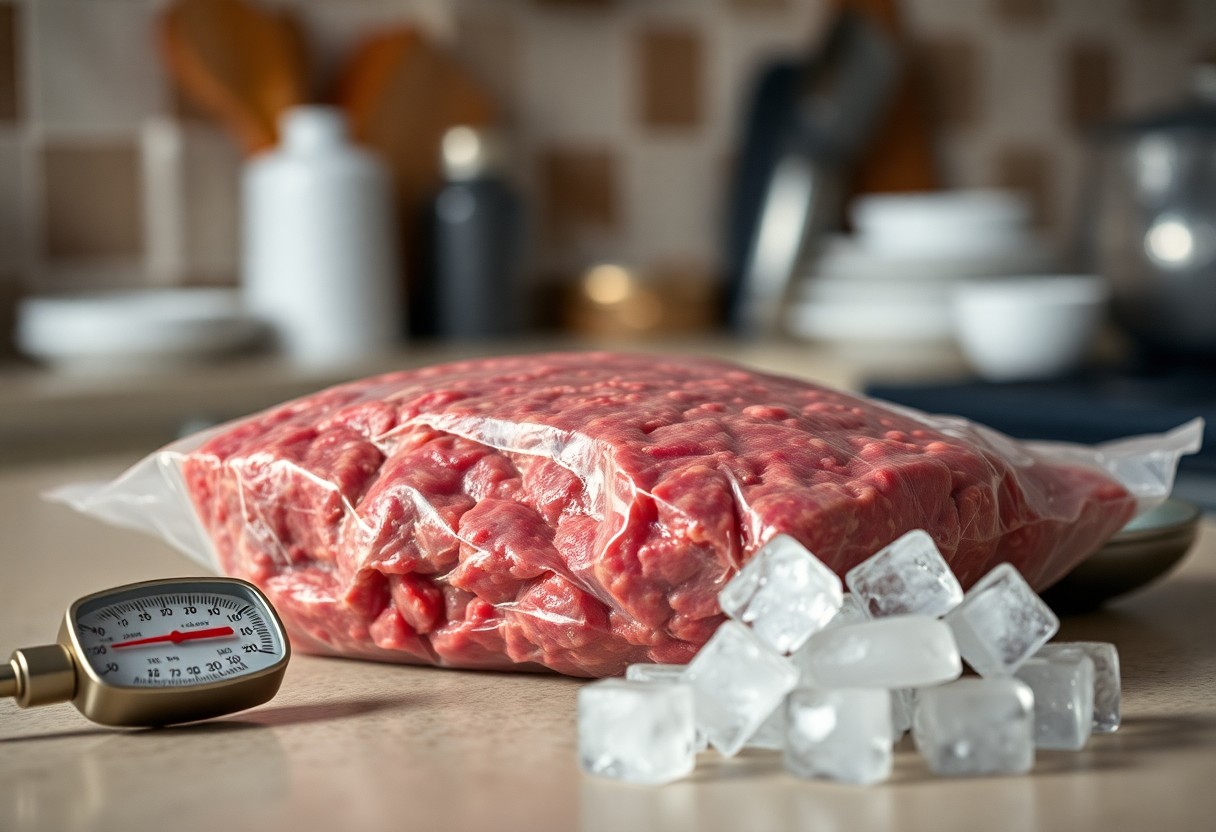There’s a common question many home cooks face: can you refreeze ground beef after it’s been thawed? The short answer is yes, but there are important guidelines to follow for food safety. If the beef has been thawed in the refrigerator and has not been left out for more than two hours at room temperature, it’s safe to refreeze. However, keep in mind that refreezing can impact the texture and flavor. In this article, you’ll learn how to handle your ground beef properly to avoid any health risks and make the most of your leftovers.
Key Takeaways:
- Ground beef can be safely refrozen after it has been thawed if it was thawed in the refrigerator.
- If the ground beef was thawed using methods like microwave or cold water, it should be cooked before refreezing.
- For best quality and flavor, it is recommended to refreeze ground beef within a few days of thawing.
The Thawing Process: What You Need to Know
Understanding the thawing process is crucial to ensuring that your ground beef remains safe to eat. When you thaw ground beef, the method you choose can significantly impact its safety and quality. Thawing incorrectly can lead to the growth of harmful bacteria, potentially putting you and your loved ones at risk. Keeping track of the time and temperature during thawing helps maintain the meat’s integrity and ensures that it remains fresh for later use.
Safe Methods for Thawing Ground Beef
There are three safe methods for thawing ground beef: in the refrigerator, in cold water, and in the microwave. Thawing in the refrigerator is the safest and keeps the beef at a stable temperature. Cold water thawing requires sealing the beef in an airtight package and immersing it in cold water, changing the water every 30 minutes. The microwave method, while quick, often leads to uneven thawing, so cook the beef immediately after defrosting.
Key Temperature Guidelines and Safety Considerations
Maintaining proper temperature guidelines during thawing is crucial for food safety. Ground beef should be kept at or below 40°F (4°C) to inhibit bacterial growth. Once thawed in the refrigerator, it should be consumed within 1 to 2 days. If using cold water, the beef should be cooked immediately after thawing, and when using the microwave, follow the cooking instructions to ensure even heat distribution. Understanding these guidelines helps you enjoy your meals without compromising safety.
Key Temperature Guidelines and Safety Considerations
| Temperature/Food Safety Guideline | Recommendation |
|---|---|
| Thawing Ground Beef in Refrigerator | Keep below 40°F (4°C) and use within 1-2 days |
| Thawing Ground Beef in Cold Water | Change water every 30 minutes; cook immediately |
| Thawing Ground Beef in Microwave | Cook immediately after thawing |
Sticking to temperature guidelines during thawing can mitigate any potential risks. Ground beef should not be left at room temperature for over two hours, as this can lead to a bacterial explosion with pathogens like Escherichia coli and Salmonella. With proper thawing methods in mind, you can ensure the beef stays safe and tasty, perfectly ready for your favorite recipes.
Understanding the Refreezing Process
Refreezing ground beef requires a solid grasp on the science behind food safety and quality. When meat is thawed, especially if it’s been in the danger zone temperature (between 40°F and 140°F) for longer than two hours, bacteria can grow rapidly. Therefore, the method of thawing plays a significant role; thawing in the microwave or cold water may render your beef less safe to refreeze compared to refrigerator-thawed meat. Understanding this process ensures you’re not only protecting your health but also maintaining the quality of your ground beef.
Factors Influencing the Safety of Refreezing
Several factors will affect whether you can safely refreeze thawed ground beef, including:
- Thawing method (refrigerator, cold water, microwave)
- Time spent in the danger zone
- Initial freezing conditions and storage time
Recognizing these elements helps you make informed decisions about your ground beef and its safety for refreezing.
Changes in Texture and Quality After Refreezing
Refreezing ground beef can result in noticeable changes in texture and quality. As ice crystals form during the freezing process, they can damage the cellular structure of the meat. This damage leads to a loss of moisture and can create a dry, crumbly texture once cooked. Additionally, flavors may become compromised due to the breakdown of proteins and fats, potentially leading to a less enjoyable culinary experience. The overall quality is often diminished, making freshly thawed beef a more desirable option.
When you refreeze ground beef, it’s likely to undergo physical alterations that can affect your dishes. Ground beef naturally retains moisture, allowing it to remain tender and juicy during cooking. However, refreezing introduces ice crystals that pierce the meat fibers, resulting in moisture loss. This can leave the beef drier than expected and may alter its ability to absorb flavors during the cooking process. Over time, you may notice a degradation of its luscious texture, which is why opting for immediate use of thawed ground beef is always the best practice.

Practical Tips for Safe Refreezing
To safely refreeze ground beef, ensure you follow these tips to maintain quality and safety:
- Refreeze only if the beef was originally thawed in the refrigerator
- Use ground beef within one to two days after thawing
- Ensure the beef has been kept at a temperature below 40°F
- Divide larger portions into smaller packages for quicker cooling
Assume that following these guidelines will not only keep your ground beef safe but will also preserve its flavor and texture.
Best Practices for Refreezing Ground Beef
For optimal results, refreeze ground beef as soon as possible after thawing. If you thawed it in the refrigerator, it can remain safe for up to two days before refreezing. Pay attention to texture; if it becomes slimy or discolored, it’s best to discard it. Utilizing a vacuum sealer or airtight containers can result in higher quality after refreezing.
Packaging and Labeling Techniques for Freshness
Effective packaging is imperative for maintaining the quality of refrozen ground beef. Using airtight containers or vacuum-sealed bags minimizes exposure to air, preventing freezer burn. Label your packages with the date of freezing and usage guidelines so you can easily keep track of freshness.
Even when dealing with ground beef, the type of packaging you use can significantly affect its lifespan in the freezer. Vacuum-sealing is the top recommended method as it removes air that creates ice crystals, leading to freezer burn. If vacuum-sealing isn’t available, heavy-duty freezer bags with excess air removed can work well. Always date your packages so that you can use them within a safe period, ideally within three to four months for the best quality. By following these packaging and labeling techniques, you’ll ensure your ground beef remains delicious and safe to enjoy at a later date.

Addressing Common Concerns and Myths
Myths about refreezing ground beef often lead to confusion and uncertainty. For example, many people believe that once meat has been thawed, it cannot be refrozen under any circumstances. However, as long as certain guidelines are followed, such as maintaining proper temperatures and minimizing time spent at room temperature, refreezing can be done safely without compromising the quality significantly.
Debunking Misconceptions About Refreezing
Common misconceptions suggest that refreezing thawed beef will always lead to spoilage or an unsafe product. In reality, as long as the meat has been handled correctly, you can refreeze it without fear of harm. Quality may decline slightly due to moisture loss, but the safety remains intact if your practices have prioritized hygiene and temperature control.
Perspectives from Food Safety Experts
Food safety experts emphasize that the key to safe refreezing lies in how the ground beef was thawed. If thawed in a refrigerator rather than at room temperature, the risks significantly decrease. Many guidelines from organizations like the USDA recommend refreezing if ground beef is still within the recommended thawing time frame, usually within three to five days after being thawed refrigerated. Following these principles will keep your ground beef both safe and satisfactory.
To wrap up
Summing up, you can refreeze ground beef after it has been thawed, but only if it was defrosted in the refrigerator and has not exceeded two days in that state. While refreezing can be safe, it’s important to understand that the quality may decrease each time you freeze and thaw meat. If your ground beef was thawed through methods like microwave or cold water, it’s best to cook it first before considering refreezing. Always prioritize food safety to ensure your meals remain healthy and delicious.
FAQ
Q: Can I refreeze ground beef after it has been thawed?
A: Yes, you can refreeze ground beef after it has been thawed, as long as it was thawed in the refrigerator and has not been left out at room temperature for more than two hours. Refreezing should be done before the beef has reached its cooking temperature.
Q: What happens if I thaw ground beef and leave it out for too long?
A: If ground beef has been left out at room temperature for more than two hours, it increases the risk of bacterial growth. In such cases, it’s best to discard the meat rather than refreezing it to avoid foodborne illness.
Q: How should I properly thaw ground beef before refreezing?
A: The best method to thaw ground beef is in the refrigerator. This allows the meat to thaw evenly and remain at a safe temperature. Once thawed, if you choose to refreeze it, use it as soon as possible to ensure quality and safety.
Q: Does refreezing affect the quality of the ground beef?
A: Yes, refreezing can affect the quality of ground beef. Each time meat is frozen, its cell structure can be damaged, leading to potential texture changes. To minimize this, consider using vacuum sealing or airtight packaging to preserve its quality better.
Q: Is there a limit to how many times I can refreeze ground beef?
A: While you can technically refreeze ground beef several times, it is recommended to limit the number of times you do so. Frequent refreezing can lead to greater declines in flavor and texture, so it’s best to only refreeze when absolutely necessary and to consume it as fresh as possible.
